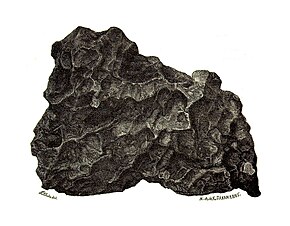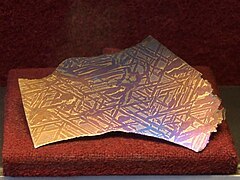| Hraschina | |
|---|---|
 Drawing of the main mass | |
| Type | Iron |
| Structural classification | Medium octahedrite |
| Class | IID |
| Composition | Fe 89%, Ni 10.5%, Ge 89.4 ppm, Ga 74.5 ppm |
| Country | Croatia |
| Region | Hrvatsko Zagorje |
| Coordinates | 46°06′N 16°20′E / 46.100°N 16.333°E[1] |
| Observed fall | Yes |
| Fall date | 26 May 1751 |
| TKW | about 49 kg[1] |
| Alternative names | Agram, Hrascina, Hrasina, Zagrab, Zagreb, Zagrebačko željezo[1] |
 Etched slice with Widmanstätten patterns, Naturhistorisches Museum Wien | |
Hraschina is the official name of an iron meteorite that fell in 1751 near the village of Hrašćina in Hrvatsko Zagorje, Croatia.[1][2] This meteorite is important because it was the first fall of an iron meteorite viewed and reported by a significant number of witnesses,[3] despite its low remaining total known weight.[2] The Hraschina meteorite also proved that rocks really can "fall from the skies".[4]
- ^ a b c d Meteoritical Bulletin Database: Hraschina
- ^ a b Horejsi, Martin. "Hraschina put the H in Historical!". Meteorite-Times Magazine. Martin Horejsi's Meteorite and Tektite Books. Retrieved July 28, 2011.
- ^ Cite error: The named reference
Reportwas invoked but never defined (see the help page). - ^ "Hraschina". Historic Falls. Archived from the original on November 15, 2011. Retrieved July 28, 2011.